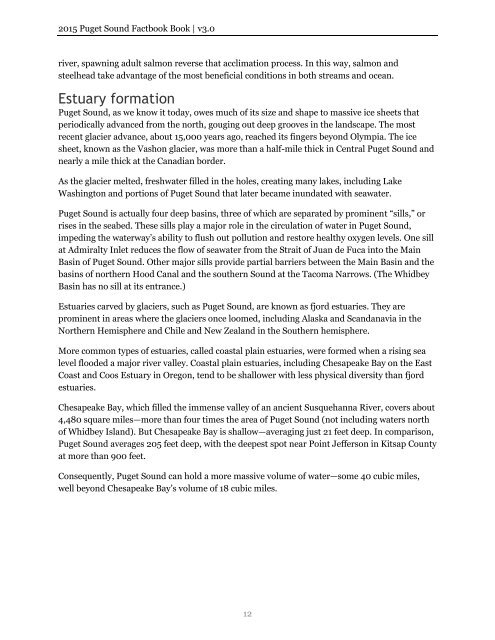Create successful ePaper yourself
Turn your PDF publications into a flip-book with our unique Google optimized e-Paper software.
2015 <strong>Puget</strong> <strong>Sound</strong> Factbook Book | v3.0<br />
river, spawning adult salmon reverse that acclimation process. In this way, salmon and<br />
steelhead take advantage of <strong>the</strong> most beneficial conditions in both streams and ocean.<br />
Estuary formation<br />
<strong>Puget</strong> <strong>Sound</strong>, as we know it today, owes much of its size and shape to massive ice sheets that<br />
periodically advanced from <strong>the</strong> north, gouging out deep grooves in <strong>the</strong> landscape. The most<br />
recent glacier advance, about 15,000 years ago, reached its fingers beyond Olympia. The ice<br />
sheet, known as <strong>the</strong> Vashon glacier, was more than a half-mile thick in Central <strong>Puget</strong> <strong>Sound</strong> and<br />
nearly a mile thick at <strong>the</strong> Canadian border.<br />
As <strong>the</strong> glacier melted, freshwater filled in <strong>the</strong> holes, creating many lakes, including Lake<br />
Washington and portions of <strong>Puget</strong> <strong>Sound</strong> that later became inundated with seawater.<br />
<strong>Puget</strong> <strong>Sound</strong> is actually four deep basins, three of which are separated by prominent “sills,” or<br />
rises in <strong>the</strong> seabed. These sills play a major role in <strong>the</strong> circulation of water in <strong>Puget</strong> <strong>Sound</strong>,<br />
impeding <strong>the</strong> waterway’s ability to flush out pollution and restore healthy oxygen levels. One sill<br />
at Admiralty Inlet reduces <strong>the</strong> flow of seawater from <strong>the</strong> Strait of Juan de Fuca into <strong>the</strong> Main<br />
Basin of <strong>Puget</strong> <strong>Sound</strong>. O<strong>the</strong>r major sills provide partial barriers between <strong>the</strong> Main Basin and <strong>the</strong><br />
basins of nor<strong>the</strong>rn Hood Canal and <strong>the</strong> sou<strong>the</strong>rn <strong>Sound</strong> at <strong>the</strong> Tacoma Narrows. (The Whidbey<br />
Basin has no sill at its entrance.)<br />
Estuaries carved by glaciers, such as <strong>Puget</strong> <strong>Sound</strong>, are known as fjord estuaries. They are<br />
prominent in areas where <strong>the</strong> glaciers once loomed, including Alaska and Scandanavia in <strong>the</strong><br />
Nor<strong>the</strong>rn Hemisphere and Chile and New Zealand in <strong>the</strong> Sou<strong>the</strong>rn hemisphere.<br />
More common types of estuaries, called coastal plain estuaries, were formed when a rising sea<br />
level flooded a major river valley. Coastal plain estuaries, including Chesapeake Bay on <strong>the</strong> East<br />
Coast and Coos Estuary in Oregon, tend to be shallower with less physical diversity than fjord<br />
estuaries.<br />
Chesapeake Bay, which filled <strong>the</strong> immense valley of an ancient Susquehanna River, covers about<br />
4,480 square miles—more than four times <strong>the</strong> area of <strong>Puget</strong> <strong>Sound</strong> (not including waters north<br />
of Whidbey Island). But Chesapeake Bay is shallow—averaging just 21 feet deep. In comparison,<br />
<strong>Puget</strong> <strong>Sound</strong> averages 205 feet deep, with <strong>the</strong> deepest spot near Point Jefferson in Kitsap County<br />
at more than 900 feet.<br />
Consequently, <strong>Puget</strong> <strong>Sound</strong> can hold a more massive volume of water—some 40 cubic miles,<br />
well beyond Chesapeake Bay’s volume of 18 cubic miles.<br />
12


